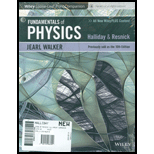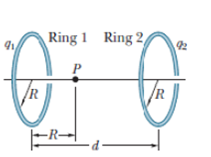
FUND.OF PHYSICS(LL)-PRINT COMP-W/ACCESS
11th Edition
ISBN: 9781119455608
Author: Halliday
Publisher: WILEY
expand_more
expand_more
format_list_bulleted
Concept explainers
Textbook Question
Chapter 22, Problem 23P
Figure 22-47 shows two parallel nonconducting rings with their central axes along a common line. Ring 1 has uniform charge q1 and radius R; ring 2 has uniform charge q2 and the same radius R. The rings are separated by distance d = 3.00R.The net electric field at point P on the common line, at distance R from ring 1, is zero. What is the ratio q1/q2?

Figure 22-47 Problem 23.
Expert Solution & Answer
Want to see the full answer?
Check out a sample textbook solution
Students have asked these similar questions
Plz no chatgpt pls will upvote
No chatgpt pls will upvote
No chatgpt pls will upvote
Chapter 22 Solutions
FUND.OF PHYSICS(LL)-PRINT COMP-W/ACCESS
Ch. 22 - Figure 22-22 shows three arrangements of electric...Ch. 22 - Figure 22-23 shows two square arrays of charged...Ch. 22 - In Fig. 22-24, two particles of charge q are...Ch. 22 - Figure 22-25 shows four situations in which four...Ch. 22 - Figure 22-26 shows two charged particles fixed in...Ch. 22 - In Fig. 22-27, two identical circular...Ch. 22 - The potential energies associated with four...Ch. 22 - a In Checkpoint 4, if the dipole rotates from...Ch. 22 - Figure 22-28 shows two disks and a flat ring, each...Ch. 22 - In Fig. 22-29, an electron e travels through a...
Ch. 22 - In Fig. 22-30a, a circular plastic rod with...Ch. 22 - When three electric dipoles ire near each other,...Ch. 22 - Figure 22-32 shows three rods, each with the same...Ch. 22 - Figure 22-33 shows five protons that are launched...Ch. 22 - Sketch qualitatively the electric field lines both...Ch. 22 - In Fig. 22-34 the electric field lines on the left...Ch. 22 - SSM The nucleus of a plutonium-239 atom contains...Ch. 22 - Two charged particles are attached to an x axis:...Ch. 22 - SSM A charged particle produces an electric Held...Ch. 22 - What is the magnitude of a point charge that would...Ch. 22 - SSM ILW WWW In Fig. 22-35, the four particles form...Ch. 22 - GO In Fig. 22-36, the four particles are fixed in...Ch. 22 - GO Figure 22-37 shows two charged particles on an...Ch. 22 - GO Figure 22-38a shows two charged particles fixed...Ch. 22 - SSM Two charged particles are fixed to x axis:...Ch. 22 - GO Figure 22-39 shows an uneven arrangement of...Ch. 22 - GO Figure 22-40 shows a proton on the central...Ch. 22 - In Fig. 22-41, particle 1 of charge q1 = 5.00q and...Ch. 22 - In Fig. 22-42, the three particles are fixed in...Ch. 22 - Figure 22-43 shows a plastic ring of radius R =...Ch. 22 - Two charged beads are on the plastic ring in Fig....Ch. 22 - The electric field of an electric dipole along the...Ch. 22 - Figure 22-45 shows an electric dipole. What are...Ch. 22 - Equations 22-8 and 22-9 are approximations of the...Ch. 22 - SSM Electric quadrupole. Figure 22-46 shows a...Ch. 22 - Density, density, density. a A charge 300e is...Ch. 22 - Figure 22-47 shows two parallel nonconducting...Ch. 22 - A thin nonconducting rod with a uniform...Ch. 22 - Figure 22-49 shows three circular arcs centered on...Ch. 22 - GO ILW In Fig. 22-50, a thin glass rod forms a...Ch. 22 - GO In Fig, 22-51, two curved plastic rods, one of...Ch. 22 - Charge is uniformly distributed around a ring of...Ch. 22 - GO Figure 22-52a shows a nonconducting rod with a...Ch. 22 - GO Figure 22-53 shows two concentric rings, of...Ch. 22 - SSM ILW WWW In Fig. 22-54, a nonconducting rod of...Ch. 22 - GO In Fig. 22-55, positive charge q = 7.81 pC is...Ch. 22 - GO In Fig. 22-56, a semi-infinite nonconducting...Ch. 22 - A disk of radius 2.5 cm has a surface charge...Ch. 22 - SSM WWW At what distance along the central...Ch. 22 - A circular plastic disk with radius R = 2.00 cm...Ch. 22 - Suppose you design an apparatus in which a...Ch. 22 - Figure 22-58a shows a circular disk that is...Ch. 22 - In Millikans experiment, an oil drop of radius...Ch. 22 - GO An electron with a speed of 5.00 108 cm/s...Ch. 22 - SSM A charged cloud system produces an electric...Ch. 22 - Humid air breaks down its molecules become ionized...Ch. 22 - SSM An electron is released from rest in a uniform...Ch. 22 - An alpha particle the nucleus of a helium atom has...Ch. 22 - ILW An electron on the axis of an electric dipole...Ch. 22 - An electron is accelerated eastward at 1.80 ...Ch. 22 - SSM Beams of high-speed protons can be produced in...Ch. 22 - In Fig. 22-59, an electron e is to be released...Ch. 22 - A 10.0 g block with a charge of 8.00 10-5 C is...Ch. 22 - At some instant the velocity components of an...Ch. 22 - Assume that a honeybee is a sphere of diameter...Ch. 22 - An electron eaters a region of uniform electric...Ch. 22 - GO Two large parallel copper plates are 5.0 cm...Ch. 22 - GO In Fig. 22-61, an electron is shot at an...Ch. 22 - ILW A uniform electric field exists in a region...Ch. 22 - An electric dipole consists of charges 2e and -2e...Ch. 22 - SSM An electric dipole consisting of charges of...Ch. 22 - A certain electric dipole is placed in a uniform...Ch. 22 - How much work is required to turn an electric...Ch. 22 - A certain electric dipole is placed in a uniform...Ch. 22 - Find an expression for the oscillation frequency...Ch. 22 - a What is the magnitude of an electrons...Ch. 22 - A spherical water drop 1.20 m in diameter is...Ch. 22 - Three particles, each with positive charge Q, form...Ch. 22 - In Fig. 22-64a, a particle of charge Q produces an...Ch. 22 - A proton and an electron form two comers of an...Ch. 22 - A charge uniform linear density = 9.0 nC/m lies on...Ch. 22 - In Fig. 22-65, eight particles form a square in...Ch. 22 - Two particles, each with a charge of magnitude 12...Ch. 22 - The following table gives the charge seen by...Ch. 22 - A charge of 20 nC is uniformly distributed along a...Ch. 22 - An electron is constrained to the central axis of...Ch. 22 - SSM The electric field in an xy plane produced by...Ch. 22 - a What total excess charge q must the disk in Fig....Ch. 22 - In Fig. 22-66, particle 1 of charge 1.00 C,...Ch. 22 - In Fig. 22-67, an electric dipole swings from an...Ch. 22 - A particle of charge q1 is at the origin of an x...Ch. 22 - Two particles, each of positive charge q, are...Ch. 22 - A clock face has negative point charges q, 2q,...Ch. 22 - Calculate the electric dipole moment of an...Ch. 22 - An electric field E with an average magnitude of...Ch. 22 - A circular rod has a radius of curvature R = 9.00...Ch. 22 - SSM An electric dipole with dipole moment p= 3.00 ...Ch. 22 - In Fig. 22-68, a uniform, upward electric field E...Ch. 22 - For the data of Problem 70, assume that the charge...Ch. 22 - In Fig. 22-66, particle 1 of charge 2.00 pC,...Ch. 22 - In Fig. 22-69, particle 1 of charge q1 = 1.00pC...
Additional Science Textbook Solutions
Find more solutions based on key concepts
Calculate the lattice energy of CaCl2 using a Born-Haber cycle and data from Appendices F and L and Table 7.5. ...
Chemistry & Chemical Reactivity
Differentiate between these terms: chromosome, chromatin, and chromatid.
Campbell Biology (11th Edition)
A horizontal spring with spring constant 100 N/m is compressed 20 cm and used to launch a 2.5 kg box across a f...
Physics for Scientists and Engineers: A Strategic Approach, Vol. 1 (Chs 1-21) (4th Edition)
4. A photographer uses his camera, whose lens has a 50 mm focal length, to focus on an object 2.0 m away. He th...
College Physics: A Strategic Approach (3rd Edition)
Using the pKa values listed in Table 15.1, predict the products of the following reactions:
Organic Chemistry (8th Edition)
1.3 Obtain a bottle of multivitamins and read the list of ingredients. What are four chemicals from the list?
Chemistry: An Introduction to General, Organic, and Biological Chemistry (13th Edition)
Knowledge Booster
Learn more about
Need a deep-dive on the concept behind this application? Look no further. Learn more about this topic, physics and related others by exploring similar questions and additional content below.Similar questions
- Find the ratio of the diameter of silver to iron wire, if they have the same resistance per unit length (as they might in household wiring). d. Ag dFe = 2.47 ×arrow_forwardFind the ratio of the diameter of silver to iron wire, if they have the same resistance per unit length (as they might in household wiring). d Ag = 2.51 dFe ×arrow_forwardShow that the units 1 v2/Q = 1 W, as implied by the equation P = V²/R. Starting with the equation P = V²/R, we can get an expression for a watt in terms of voltage and resistance. The units for voltage, V, are equivalent to [? v2 v2 A, are equivalent to J/C ✓ X . Therefore, 1 = 1 = 1 A V1 J/s Ω V-A X = 1 W. . The units for resistance, Q, are equivalent to ? The units for current,arrow_forward
arrow_back_ios
SEE MORE QUESTIONS
arrow_forward_ios
Recommended textbooks for you
 Principles of Physics: A Calculus-Based TextPhysicsISBN:9781133104261Author:Raymond A. Serway, John W. JewettPublisher:Cengage Learning
Principles of Physics: A Calculus-Based TextPhysicsISBN:9781133104261Author:Raymond A. Serway, John W. JewettPublisher:Cengage Learning
 Physics for Scientists and Engineers: Foundations...PhysicsISBN:9781133939146Author:Katz, Debora M.Publisher:Cengage Learning
Physics for Scientists and Engineers: Foundations...PhysicsISBN:9781133939146Author:Katz, Debora M.Publisher:Cengage Learning Physics for Scientists and EngineersPhysicsISBN:9781337553278Author:Raymond A. Serway, John W. JewettPublisher:Cengage Learning
Physics for Scientists and EngineersPhysicsISBN:9781337553278Author:Raymond A. Serway, John W. JewettPublisher:Cengage Learning Physics for Scientists and Engineers with Modern ...PhysicsISBN:9781337553292Author:Raymond A. Serway, John W. JewettPublisher:Cengage Learning
Physics for Scientists and Engineers with Modern ...PhysicsISBN:9781337553292Author:Raymond A. Serway, John W. JewettPublisher:Cengage Learning College PhysicsPhysicsISBN:9781305952300Author:Raymond A. Serway, Chris VuillePublisher:Cengage Learning
College PhysicsPhysicsISBN:9781305952300Author:Raymond A. Serway, Chris VuillePublisher:Cengage Learning

Principles of Physics: A Calculus-Based Text
Physics
ISBN:9781133104261
Author:Raymond A. Serway, John W. Jewett
Publisher:Cengage Learning


Physics for Scientists and Engineers: Foundations...
Physics
ISBN:9781133939146
Author:Katz, Debora M.
Publisher:Cengage Learning

Physics for Scientists and Engineers
Physics
ISBN:9781337553278
Author:Raymond A. Serway, John W. Jewett
Publisher:Cengage Learning

Physics for Scientists and Engineers with Modern ...
Physics
ISBN:9781337553292
Author:Raymond A. Serway, John W. Jewett
Publisher:Cengage Learning

College Physics
Physics
ISBN:9781305952300
Author:Raymond A. Serway, Chris Vuille
Publisher:Cengage Learning
Electric Fields: Crash Course Physics #26; Author: CrashCourse;https://www.youtube.com/watch?v=mdulzEfQXDE;License: Standard YouTube License, CC-BY